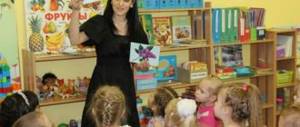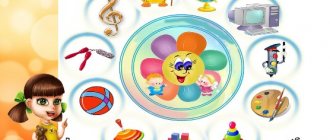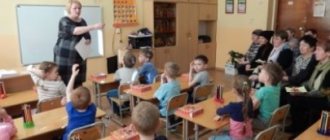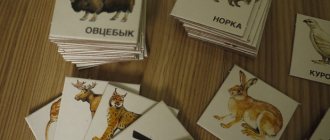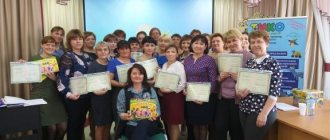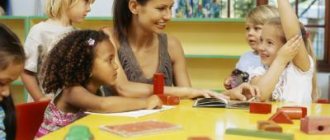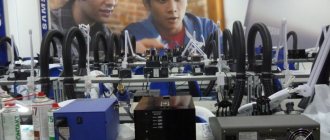The importance of circle work in preschool educational institutions
A circle in a kindergarten is an informally united group formed on the basis of the interests and preferences of children and the wishes of parents. The materials used in the work exceed the requirements of the Federal State Educational Standard, therefore the circle groups are classified as additional education in kindergarten.
Mugs perform several functions:
- Education. The child receives additional knowledge and develops certain skills in the area of interest to him.
- Upbringing. Working in a circle develops children's communication skills, social adaptation, and fosters a culture of behavior.
- Correction and development. Classes in clubs improve a child’s abilities or correct their development in case of certain deviations (for example, a speech therapy group).
Club work helps to unleash the creative potential of children
If a child attends club classes with enthusiasm, then this alone creates a situation of success for him, which means it increases self-esteem.
Goals
Circle work can be carried out for various purposes:
- Increasing knowledge and skills in a certain area or compensating for them.
- Familiarization with material not intended for study in the compulsory program.
- Formation of social skills.
- Creative development.
When creating a particular circle, the teacher must take into account:
- interests in the group;
- children's age;
- time of load on the child.
Senior group. Senior preschool age. Children 5-6 years old
Additional education program for children 5–6 years old with an artistic orientation “Creative Workshop”
Additional education program for children 5-6 years old with an artistic orientation “Creative Workshop”
Explanatory note Scientists who study the development of children's speech claim that the movement of the fingers is very closely related to speech function. Development of function...
Work program of the “A Fairy Tale Comes to Us” circle for theatrical activities in the middle group (4–5 years old) WORK PROGRAM of the “Fairy Tale Comes to Us”
for theatrical activities in the middle group
(4-5 years old)
Olga Vitalievna Ruchkina, Yuzhno-Sakhalinsk Goals and objectives
of the program . Goal of the program : Development of dialogical speech preschool children
Types of clubs in kindergarten
All group work is divided into 4 areas:
- Artistic and aesthetic development is the realization of the creative potential of students.
- Cognitive development - satisfying children's interests and curiosity.
- Physical development - gaining experience in physical activity, instilling a healthy lifestyle.
- Social and personal development - improving communication skills, social adaptation.
Fine arts clubs
Drawing develops memory, attention, fine motor skills, teaches you to think in images, and expands your imagination. An artistic drawing club that introduces children to non-traditional drawing techniques is suitable for both younger groups and older children. The teacher can experiment with showing different techniques to the children, taking into account their interest.
Drawing is one of the most favorite childhood activities
In the process of visual activity, the child gets acquainted with various objects and remembers their size, shape, color, that is, develops visual perception.
At the age of 3–4 years, a child is just beginning to form ideas about objects, so in the process of drawing, preschoolers cannot catch many details, but they actively experiment with color. Suitable:
- palm painting,
- finger painting,
- drawing with threads,
- foam printing,
- spray
Modeling is very useful for developing fine motor skills. The application will help develop children's perception.
Modeling classes develop fine motor skills, and therefore the speech abilities of a preschooler.
In the middle group, children really love to make things. At this age, children will be interested in classes on working with paper and cardboard, plasticine, fabric, and various natural materials:
- origami;
- applique;
- thread drawing;
- monotypy;
- leaf prints;
- plasticine printing;
- drawing with cotton swabs;
- wax painting.
Full communication with peers is an important factor in the formation of a harmonious personality of an older preschooler. Working in a team teaches children to respect the interests of others, develops organization, strong-willed qualities, and a communicative culture. At an older age, you can already use more complex techniques:
- drawing with soap bubbles;
- drawing with crumpled paper;
- blotography (“Kalyaka-kalyaka”);
- grattage;
- plasticineography (“Plasticine Crow”).
Photo gallery: non-traditional techniques of fine art
Drawing with palms is easy to do and suitable for the youngest students.
Monotype allows you to get a complete picture by making a mirror print of the drawn half
Using blotography you can create very expressive compositions
Drawing with soap bubbles develops children's creativity and articulation
The technique of drawing with cotton swabs is well suited for creating winter landscapes
Paintings made using the grattage technique require great care, so they are suitable for older children
Plasticineography helps create three-dimensional paintings
Table: fragment of a long-term plan for the “Kalyaka-Malyaka” circle in the first junior group
| Author | Romanovskaya E. R., teacher of MBDOU D/s "Teremok", Tsimlyansk, Rostov region | |
| Month | Subject | Tasks |
| January | “The snowball is fluttering and spinning” |
|
| "Cheerful Snowman" | Practice the poking technique with a semi-dry hard brush. | |
| “These are the legs of a centipede” |
| |
| February | "Funny Fishes" |
|
| "Car for Dad" |
| |
| "My Favorite Pets" |
| |
| "Striped towels for forest animals" |
| |
| March | "Mimosa for Mommy" |
|
| "My mittens" |
| |
| “These are the kind of icicles we have!” |
| |
| "Two merry geese lived with granny" |
| |
| "Snowdrops" |
| |
| Quote via: https://nsportal.ru/detskiy-sad/risovanie/2017/07/18/kruzhkovaya-rabota | ||
Video: master class on plasticineography
Music clubs
Music clubs accustom children to culture, develop taste, and contribute to the development of creative abilities. Singing is the main type of musical activity in kindergarten. The vocal circle helps develop hearing, memory, sense of rhythm, and promotes speech development.
At a young age, children may not yet perceive the words of a song and their meaning, but they already subtly feel the melody and rhythm. At this age, the vocal cords are thin and short, so careful handling of the child’s voice is required. Songs should be simple to perform and clear in their images. In the middle group, children's vocabulary increases, their musical horizons expand, and their articulation improves. In the older group, children develop a certain musical experience, but the vocal apparatus is still weak and vulnerable. Breathing and articulation exercises become more complex and require more attention.
Music club develops hearing and sense of rhythm in children
Regular music lessons have a beneficial effect on the development of intellectual abilities.
The following tools are used in the vocal circle:
- Technical equipment: tape recorder,
- camera,
- camcorder.
- books,
Video: concert of the vocal circle “Bell”
Cognitive activity
Educational circles develop curiosity and motivation to learn, and broaden one’s horizons. In the younger group, you can organize clubs for experimental activities: “Little Explorers”, “Colorful World”, “Young Explorers”, in which children can become familiar with the properties of sand, stone, and water.
In the middle group, it is useful to introduce classes that delve deeper into certain areas: “Entertaining mathematics”, “The world around us”, “Ecology”. In the older group, the material being studied becomes more complex and expanded (for example, “Young Magician”).
Table: long-term plan for the “Nature’s Pantry” circle in the middle group
| Author | Svetlolobova S. L., teacher of MBDOU DSOV No. 135, Bratsk, Irkutsk region | |||
| Month | Subject | Tasks | Techniques | Form of work |
| September | "Visiting Leaffall" |
|
| Club of interesting meetings |
| “Do leaves need water?” |
|
| Experimental research activities | |
| "Panel of dry leaves" |
|
| Manual labor | |
| “Whose leaf is this?” |
|
| Play activity | |
| October | “Seeing the Birds Until Spring” |
|
| Target walk |
| "Watching the Feeder" |
|
| Observation in nature | |
| "Coloring Bird Silhouettes" |
|
| Artistic activity | |
| Didactic game "Birds" |
| Didactic game "Birds" | A game | |
| November | “Which animals change color and why?” |
|
| Curious Club |
| "Hide the animals" | Learn to find surrounding objects in a group that match the color of a certain type of animal. |
| A game | |
| "Animal world and its color" |
|
| Workshop "Samodelkina" | |
| "Who lives where?" |
|
| Intellectual game | |
| Quote from: https://nsportal.ru/detskiy-sad/okruzhayushchiy-mir/2017/09/18/perspektivnyy-plan-kruzhkovoy-raboty | ||||
Physical development
Activities that help children gain experience in physical activity and develop the concept of the value of a healthy lifestyle are certainly popular with children. The “If you want to be healthy” group assumes the possession of hygiene skills in a playful way, teaching a healthy lifestyle. Children need physical activity. A football club, badminton club, etc. in a playful way will help children develop coordination and get emotional relief. A swimming club will be useful for the proper physical development of preschoolers.
Classes in a physical education club charge children with vigor and good mood for the rest of the day
Table: calendar planning for circle work “Ball School” in the senior group
| Author | Gabdrakhmanova A. M., physical education instructor at MADOU D/s No. 14 “Umka”, Megion, Khanty-Mansiysk Autonomous Okrug | ||
| Month | Subject | Tasks | Content |
| September | Diagnostics | Determine the level of physical fitness of children. |
|
| Diagnostics | Determine the level of physical fitness of children. |
| |
| History of the ball |
|
| |
| Ball throws |
|
| |
| Ball toss |
|
| |
| Ball throws |
|
| |
| October | Ball throws |
|
|
| Throwing the ball |
|
| |
| Medicine ball rolling |
|
| |
| Throwing the ball |
|
| |
Table: common circles created in preschool educational institutions
| Name options | Kind of activity | Forms of working with children | Children's age |
| Artistic, aesthetic, creative (making crafts) |
| For children of any age |
| "Lego" | Constructive |
| Starting from the second youngest group |
| "Robotics" | Developmental |
| Senior, preparatory group |
| "Beading" | Creative, artistic and aesthetic |
| Senior, preparatory group |
| "Magic needle" | Artistic work |
| Senior, preparatory group |
| Corrective-developmental, educational |
| For children of any age |
| "Psychological circle" | Socialization |
| For children of any age |
| "Develop it" | Development of fine motor skills of hands, attention |
| Second junior and middle groups |
| Physical development, artistic and aesthetic |
| For children of any age |
| "Rhythm" | Physical development, artistic and aesthetic |
| For children of any age |
| "Vocal circle" | Artistic and aesthetic |
| For children of any age |
| "Orchestra" | Artistic and aesthetic |
| Senior, preparatory group |
| "The big guy" | Physical education and health |
| For children of any age |
| Physical education and health |
| For children of any age |
| "Nordic walking" | Physical education and health |
| Senior, preparatory group |
| "Badminton" | Physical education and health |
| Starting from the senior group |
| "Funny Ball" | Physical education and health |
| Junior group |
| "Football" | Physical education and health |
| Starting from the middle group |
| "Swimming" | Physical education and health |
| Starting from the second youngest group |
| "LFC" | Physical education and health |
| For children of any age |
| Cognitive, developing |
| Starting from the middle group |
| Artistic-aesthetic, educational, educational |
| For children of any age |
| "Teaching Reading" | Cognitive, speech development |
| Senior, preparatory group |
| "Certificate" | Educational |
| Senior, preparatory group |
| "Patriotic education" | Socialization with an emphasis on civic-patriotic education |
| Senior, preparatory group |
| "The world" | Cognitive |
| Starting from the middle group |
| Cognitive, environmental education |
| For children of any age |
| Folklore circle | Educational, educational |
| Starting from the middle group |
| ISO | Artistic and aesthetic |
| For children of any age |
Table: fragment of a summary of a speech therapy lesson in the “Govorusha” circle in the middle group
| Author | Afanasyeva O. V., teacher-speech therapist MBDOU D/s No. 147 “Smile” of a combined type, Cheboksary, Chuvash Republic |
| Subject | "Sound and letter O" |
| Relevance | Children with speech development disorders make up 80% of all children, so the importance of creating speech therapy clubs in this case is simply undeniable. |
| Tasks |
|
| Equipment |
|
| Progress of the lesson | A monkey comes in and greets the children. Q: “Guys, let’s say hello to the monkey, she loves to play and invites you to take part in the game “Echo.” Game "Echo". Children repeat the following sounds after the monkey:
V.: “Now let’s show the monkey some gymnastics exercises.” Articulation gymnastics “Tube”, “Smile”. V.: “Guys, the monkey is surprised. Show us how surprised we are?” Children show emotions with facial expressions. Next, the teacher reads the fairy tale “Living Sounds” to the children:
Next comes the game “Find the Picture”. Pictures and shapes of clouds, islands and lakes are laid out on the table. The guys must arrange pictures with words with the sound O into the appropriate shapes. |
Report on the work of the circle at the preschool educational institution
A report on the work done in the circle is a mandatory document in the preschool education system. The teacher usually presents it at the end of the year. The purpose of creating the circle and its tasks are indicated. For example, the “Skillful Hands” club in the senior group of a preschool educational institution aims to reveal the creative potential of children and instill a love for the fine arts.
The following tasks were set:
- Development of creative thinking in children.
- Development of fine motor skills of the hands.
- Development of skills in working with various materials.
- Cultivating accuracy and independence.
Children, working in a team, learn to value their own work and evaluate the work of others. Social adaptation and the ability to work in a group develop. At each lesson, the children were given information about the materials being presented and how to work with them. Parents were familiarized with the work of the circle and helped in its organization: they bought the necessary materials and corrected the children’s work. The works made by the students were presented to parents or children in the group for various holidays: New Year, March 8, February 23, Mother's Day. Classes were held once a week for 25–30 minutes.
Various forms of conducting classes were used:
- conversation,
- teacher's story,
- preparation for work,
- production of works,
- exhibition of works,
- donation.
At the end of the year, preschoolers learned:
- work with paper;
- work with scissors and glue;
- plan work, voice your ideas;
- make paper crafts for gifts;
- implement creative ideas.
Photo gallery: photo report on the work of the “Skillful Hands” club in the senior group of kindergarten
In a team, children learn to respect their interests and other children
Working with glue, paper and scissors develops fine motor skills
When creating works, children use their imagination, thereby developing creative thinking.
When working with small parts, you must be careful and attentive.
The child can present his work as a gift to his parents, teacher or children in the group
Exhibiting finished works is an important moment in helping children gain self-confidence
Depending on the preferences of the children, the recommendations of parents and the capabilities of the preschool institution, you can create any circle in the kindergarten. In additional classes, preschoolers will be able to gain new knowledge, useful skills and positive emotions, increase self-esteem and develop creative abilities.
“A creative workshop is one of the modern forms of working with children in preschool educational institutions.”
A creative workshop is one of the modern forms of working with children in preschool educational institutions.
1 slide
Dear colleagues, today I would like to introduce you to one of the modern forms of joint activity between a teacher and children - a creative workshop.
2slide
Creativity in the broad sense of the word is an activity aimed at obtaining something new, unique
3slide
A creative workshop is one of the forms of educational activity that allows children to show their initiative, as it provides an opportunity to satisfy their desires and needs in creativity.
The goal of working in a creative workshop is to preserve the child’s creativity; providing assistance in realizing its capabilities; promoting the development of independence and creative personality; development of cognitive interest of preschool children in the objective world.
4slide
The very concept of “workshop” came to pedagogy from the sphere of creativity, initially implying a place where something new is created, which did not exist until today.
The workshop is a conventionally designated group space with tables arranged into one common table so that the children and the teacher can sit together.
A workshop (into which a group room is temporarily transformed) is a specially organized space where beautiful, interesting and necessary things for a child’s life are purposefully created.
In kindergarten, there are several types of workshops depending on the composition of participants, goals and methods of activity, and the time duration of the process.
5slide
Workshops are divided according to the composition of participants:
- classes only for children;
- only for teachers
- only for parents (legal representatives)
- which can be carried out with both adults and children.
6slide
By goals and types of activities the following are distinguished:
— art workshop (includes appliqué, drawing, sculpting);
— theatrical (production of costume elements, invitation cards, posters, scenery);
— workshop of games and toys (furniture made from matchboxes, toys from boxes);
— souvenir workshop (making greeting cards, gifts for kindergarten employees, guests);
- architectural workshop (production of models of houses, roads, maps of the village, landscape models - mountains, volcanoes).
7slide
According to their duration, workshops are divided into “one-act” (during one lesson) and long-term (2-3 lessons), when the work is intermittent and can last a week (immersion method) or even for several weeks.
The use of a workshop is possible both as an independent unit, organized free of continuous educational activities, and as a form of organizing classes (or as part of it) when conducting a complex lesson.
Each workshop necessarily has a master teacher whose task is to include the child in the process of individual creative cognitive activity, help him make a discovery, and give him the joy of creating new, independently acquired knowledge.
8 slide
Work in a creative workshop can be carried out according to the following algorithm:
Motivation; discussion of what was seen; planning upcoming work together with children; distribution of responsibilities at the request of children if they work in pairs or in a microgroup; joint activities of the teacher and children; performance analysis
9slide
When organizing a workshop, a number of essential conditions must be observed. So N.A. Korotkova, I.A. Mukhin distinguishes the following conditions.
It is necessary to organize a common space for work. This can be a large work table (or several tables), made from ordinary tables moved together with the necessary materials, tools, samples.
These may be separate places for individual work.
Seats must be provided at the desk for all potential participants, including for the teacher, who does not separate himself from the children, but sits next to them. It is not recommended to strictly assign places for children, as in a lesson; here everyone can sit wherever they want, choosing their own neighbors from time to time. Children can move freely around the room if they need some kind of tool or material. The position of the teacher is also dynamic, who at each workshop is located next to one or another child who requires increased attention due to existing difficulties in this type of work or material and tools.
A common workspace organized in this way promotes a sense of freedom, provides the opportunity for each participant to see the actions of others, freely discuss goals, progress of work and results obtained, exchange opinions and discoveries “Look how mine is”, “I understand how it’s done!”
The second condition is the possibility of communication between workshop participants with each other, where dialogue (between workshop participants, individual groups, with oneself) is the main principle of interaction, cooperation, and co-creation in the course of work.
The next condition, according to N.A. Korotkova, the point is that when starting a lesson, an adult does not oblige or force them to do it, but draws their attention to the prepared materials and puts forward interesting ideas for work. In other words, the teacher offers children several goals (samples, diagrams) or different materials for the implementation of one goal in order to provide a choice based on interests and capabilities.
The teacher is involved in activities on an equal basis with the children - having chosen a goal for himself, he begins to act, becoming a living example of the systematic organization of work. He does not instruct or control the children (this is the style of the educational lesson), but discusses ideas, analyzes samples with them, and comments on the steps of his work; by his very active presence and desire to obtain the final result, he supports this desire among the other participants.
The atmosphere created when working in the workshop should contribute to the creative self-development of the child’s personality and stimulate him. “At the same time, it is important not only what we learn, but also what feelings and emotions we experience.” Therefore, the teacher is required to pay special attention to the state of the child’s emotional sphere.
An important condition in this situation is that the activity in the workshop should be non-evaluative, i.e. Critical remarks addressed to any workshop participant are unacceptable, which creates conditions of emotional comfort and creative freedom with the implementation of the principles of “pedagogy of success.”
As noted by N.A. Korotkov, the work offered to children should be designed by the teacher for 25-30 minutes, necessary to achieve the final goal (based on the pace of work of the “average” child of the group), and it is necessary to have some reserve of time so that everyone can, without rushing, get involved in the activity, deal with it at your own pace.
In this regard, another important condition when organizing a workshop is the fact that all activities have an open temporary end.
As they complete (achieve the goal accepted by each) children move on to free activities of their own choice. At this time, the adult does not leave the “work field” until everyone has completed their work, encouraging slow children with his presence.
Thus, children are offered work that involves the achievement of their own (personal) holistic product by each group member. The final products of all participants, without losing their independent value, can ultimately form a common product - a collection, a model, a large panel, etc. In other words, all members of the group can work together, side by side in a common semantic field, but each asserts himself in his own result. The result of work in the workshop is not only real knowledge or skill, but the process of comprehending the truth and the creation of a creative product are important.
And now we present to your attention a little experience in organizing a creative workshop in our group.
10-11 slide
The creative workshop began its work to prepare works for the exhibition of children's creativity “Winter Motifs”. A collective work “Winter Forest” was created. It turned out to be a wonderful landscape! The forest in them looks like a fairy tale, magic, the trees turned out slender, snow-covered, like lace.
11 words Individual works “Beautiful Christmas Tree” and “Snowman” were also created.” The guys united them with the common plot of “New Year’s Friends.”
12,13,14 slides
On the eve of the New Year holidays, the guests of our group were students from the Satis secondary school.
The meeting took place in the form of a creative workshop. Schoolchildren showed the children a theatrical fairy tale “Beasts in the Winter Forest”.
13 words Then the preschoolers and their guests went to a creative workshop, where they jointly created collective works using the “Bear in the Den” appliqué. The meeting was held on a positive note; the students, who were able to plunge into the world of preschool childhood and preschool children, received a lot of pleasant impressions from communicating with their older friends.
14 words At the end of the meeting, the schoolchildren presented their little friends with shovels made with their own hands in the school workshop.
15-16 slide
On the eve of Defender of the Fatherland Day, work began in the creative workshop on making gifts for dads.
16 words The children glued and decorated tea cups with the symbol of the country - the Russian flag. Individual works were also completed for a creative exhibition.
17-slide
Before the holiday “March 8 ” “Bouquets for Mothers” opened in our group . The children made a bouquet from their palms for their most beloved mothers. During the event, the children spoke touchingly and tenderly about their mothers; during a word game - “My mother is the most, the most,” the children found tender and affectionate words for their mothers. Everyone without exception took an active part in the workshop! They say that a child’s palms are little suns, they contain warmth, tenderness and love. This is doubly pleasant and valuable because the work is done in a team with other children.
18slide
The children prepared flowers for their beloved grandmothers. They are made by the hands of children, with a special feeling of warmth and love, and carry tenderness and love for close and dear people.
19-21 slide
For the Easter holiday, the Souvenir Workshop began its work, where crafts and souvenirs were prepared - “Chicken with an Easter egg”.
20 words The children made a chicken out of paper and decorated feathers with bright colors—a house for an Easter egg. Then the egg was painted with various patterns.
21 words Each child gave their loved ones a hand-made souvenir and evoked joy in anticipation of the bright Easter holiday.
22-26slide
22slide On the open day, a parent-child creative workshop opened in the group, which is one of the most effective forms of interaction between family and kindergarten. The parents and their children followed in the footsteps of the bunny and helped him change his white coat to a gray one.
23slide The main role in the creation and functioning of a parent-child creative workshop is played by the activities of the teacher.
Slide 24 With interested informal communication, parents’ anxiety disappears, a feeling of trust in the teacher and readiness to interact with him appears.
Slide 25 Parents and their child sculpt, draw, create something new and unusual. They become part of the child’s life, not the one where mom and dad worry about whether he has eaten? did you sleep? Did you dress warmly? And the one where the child is the little creator. Where did he come up with it himself? I did it myself! He is already an adult, they have common joys and questions.
Slide 26 And the work that the children and parents produce is worthy of all praise.
27slide
I would like to end my speech with the words of the great teacher Sukhomlinsky. He said:
“There is a bird sleeping inside every child that needs to be awakened to fly. Creativity is the name of this magical bird!”
The sooner a child awakens this bird within himself, the sooner he learns to see the beauty of the world around him, understand the language of nature, music, poetry, rejoice and be surprised, the brighter, more emotional, and purer he will be.
